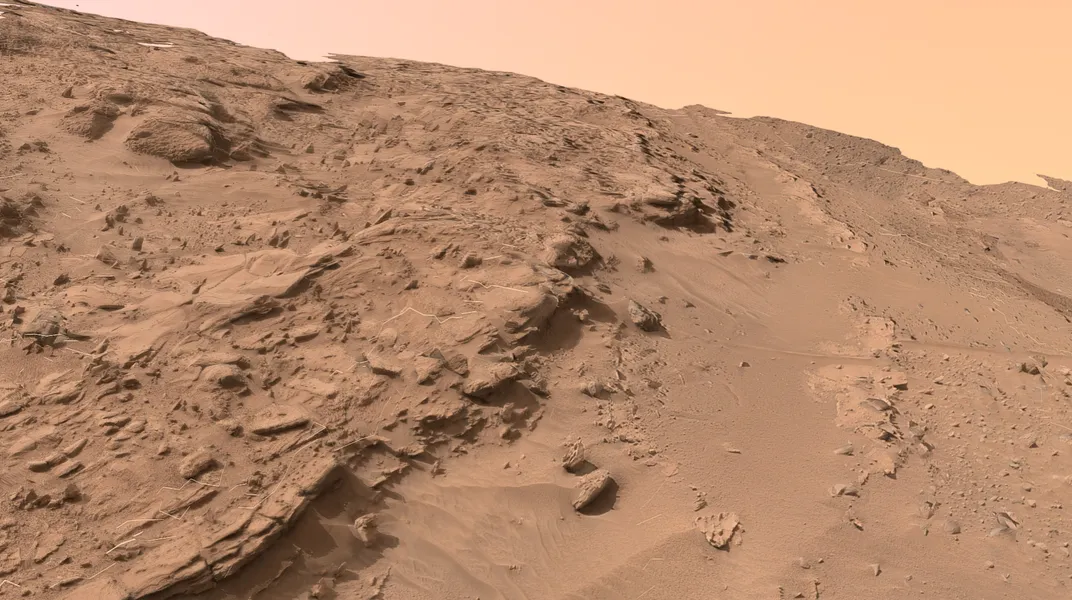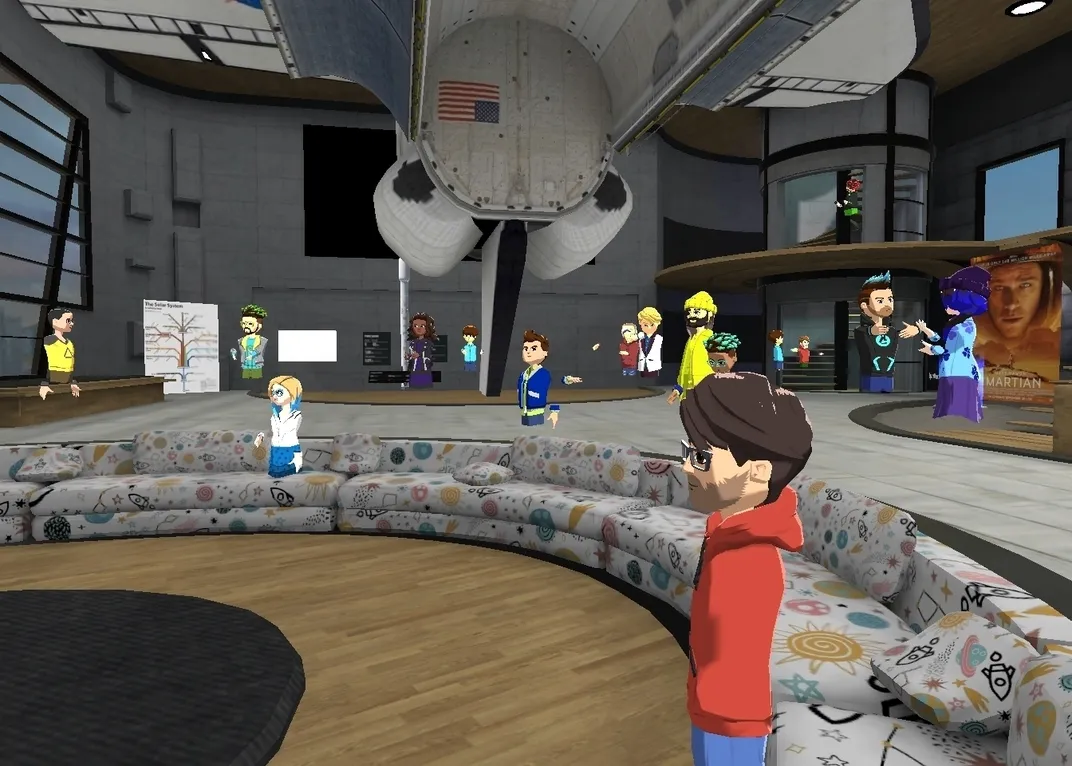Five Space Experiences to Try With Your New VR Headset
The technology is getting better, and so is the content.
/https://tf-cmsv2-smithsonianmag-media.s3.amazonaws.com/filer/54/cf/54cf1c68-36e9-4e76-9dd3-09b96b0cb52b/2nd_step.jpg)
Over the past year, with millions of housebound office workers trying tele-presence for the first time, did virtual reality find its true purpose at last? Nah, not really. This always-just-about-to-take-off technology is still, by and large, a niche hobby for early adopters.
That doesn’t mean it can’t be a lot of fun, though, or even, at times, revolutionary. And it’s only going to get better. Here are some recommendations for worthwhile space-related experiences you can try right now, most of them for standalone headsets like Oculus Quest, which (as opposed to more expensive tethered headsets) appear to be the future of consumer VR.
Space Explorers: The ISS Experience
Astronauts have always carried along the best possible cameras for documenting their adventures. On the moon, it was 70mm Hasselblads. In the shuttle era, bulky IMAX cameras captured footage for large-screen films like The Dream is Alive and Destiny in Space, and IMAX upped its own game in 2002 with Space Station 3D. But, good as these films were, they mostly showed the same kinds of pictures we’d always seen, only bigger.
Now comes Space Explorers: The ISS Experience, which is something altogether different. It’s not the first 360-degree video shot in space, but it’s easily the best. (Be sure to watch the trailer below in full-frame, and click and drag to look around.)
In partnership with TIME, VR film pioneers Felix & Paul Studios sent a basketball-size VR camera up to the space station in 2018, and for the next two years, astronauts used it to capture you-are-there scenes of everyday life onboard. Some of it was scripted—members of the Expedition 59 crew looking directly at us, explaining how they maneuver in zero-g or what they find inspiring about space exploration. But the best stuff was not. Directors Félix Lajeunesse and Paul Raphaël gave the astronauts general guidance about what scenes to capture, and after that they were free to film what they wanted.
The only episode released so far, Adapt, opens with the crew’s morning wake-up routine as they float out of their sleeping bunks and start flicking on the lights. You (the 360 camera) are right there with them, able to look in any direction and take in the whole scene. Later, when Anne McClain shows newly arrived Christina Koch around the station, there’s no script, just us floating alongside them, eavesdropping. Same with a scene around their crowded dinner table, the camera positioned as if we were just another member of the crew. So real was the sense of presence that when my wife watched in a Quest headset, she actually scrunched over to avoid bumping shoulders with the person next to her.
In one remarkable scene, captured serendipitously when Nick Hague had the camera running to document his exercise routine, the astronauts react to what turned out to be a false alarm. You can see the real concern on their faces—not fear, such alarms are not uncommon on the space station—as they discuss what emergency procedures they need to follow. Credit to NASA for allowing this scene to be included. Better than anything else in the film, it shows the power of VR to show us what really happens in space, free of any imposed narrative or single perspective. More episodes in the series will be released this year, and there are plans to film a spacewalk. I can’t wait.
Space Explorers: The ISS Experience, available for Oculus Quest and Rift
Mission: ISS
Enthralling as it is, one key thing missing from The ISS Experience is that you’re watching rather than participating. That’s where Mission: ISS comes in. It takes advantage of the Oculus Touch hand controllers to let you float freely around the station, pushing off walls, grabbing onto handrails, and picking up (or tossing around) stowage bags and tools. I’ve never been in zero-G, but the physics seem pretty real, and you suffer the clumsiness of the newbie astronaut as you try to aim your trajectory and control your speed without crashing.
The graphics are, well, good enough. It isn’t actual photography of the station, but the detailed animation is based on the real thing. And your ability to roam around the station, exploring wherever you want, more than makes up for what you might lose visually.
I’m not much for “gamified” space experiences where you pretend to be landing a spaceship on Mars or driving a rover on the moon. There’s nothing really to accomplish in Mission: ISS except to enjoy yourself, and imagine that you‘re really onboard the station. The app has been available from the Oculus Store for several years, but it’s still one of the best space-related VR experiences out there.
Mission: ISS is available for all Oculus headsets, and even works in reduced form in Gear VR.
Sketchfab

Beat Saber and shooter games like Half-Life: Alyx may get all the attention, but to my mind, Wander (think Streetview for VR) and Sketchfab are the most underrated experiences for consumer VR. I’d buy a headset for these two alone.
Sketchfab, an online repository of 3D Models, is not an actual app, but you can access it through your headset browser. It’s like flickr for VR. There’s a fantastic variety of scanned models, all available to view or download (some for a fee), and you’ll find everything from banana bread to Bernie to the Sistine Chapel. Not surprisingly, this includes a lot of space stuff. The Smithsonian has made many objects from its digitized collection freely available, including the Apollo 11 command module and space shuttle Discovery. Other Sketchfab users can download these models and modify or adapt them, like this model of Neil Armstrong’s glove.
Some user-uploaded models on Sketchfab look cheesy, but many are professionally scanned or are based on real, detailed data. For example, the Laboratoire de Planétologie et Géodynamique in France has posted a number of moon- and Mars-scapes to explore. And that’s the magic of it. When you hit the VR icon in your headset browser, you’re immediately transported inside whatever model you’re viewing. If it’s a house, it will look like you’re in a life-size house.
The hallmark of so-called six-degrees-of-freedom VR (like you get with the Quest, Rift, and other current-generation headsets like Vive) is that you can move around in these virtual spaces (limited by the size of your actual playing room, that is). So I have, at times, walked around Jezero crater on Mars (the intended landing site next month for NASA’s Perseverance rover) and ice mountains on Pluto.
Sketchfab is a wonderland for VR, and I look forward to more space-related 3D content being uploaded in the future.
Sketchfab models can be viewed, online or in a headset, at sketchfab.com.
Spheres
My own preference in VR experiences is for the low-key. Just show me someplace—ideally someplace I can’t go in real life—and I’ll figure out what to look at and think for myself, thanks. In these early days of VR, I’ve liked, for example, riding alongside cosmonauts during a Soyuz launch (The Missed Spaceflight) and bouncing around on the moon with past and future lunar explorers (Faber Courtial studio’s elegantly produced Into Space). These are relatively simple VR films, but in each case I came away with some new insight, however small, about what the actual experience might be like.
Spheres is more ambitious, an attempt to use VR to blow us away with the majesty of the Universe.
Director Eliza McNitt, one of the pioneers of VR filmmaking, with the aid of executive producer Darren Aronofsky (whose feature films include Pi and Black Swan) and celebrity narrators Millie Bobby Brown, Jessica Chastain and Patti Smith (cool!), take us on a dazzling tour of planets, stars and galaxies. As you might expect for an app that costs $9.99, the production values are high. It isn’t all passive viewing, either. You get to bat around the planets in their orbits like so many tetherballs, and capture the electromagnetic radiation streaming past you. It’s fun, and it’s well done.
Spheres is a bit too gushy for my taste—I often found myself impatient with the reverently whispered narration—but many people will find it educational and inspiring.
Spheres is available for Oculus Quest and Rift.
Into Space, from the German studio Faber-Courtial, is available for the Vive and Oculus Go headsets, but oddly, not for the Quest or Rift.
AltspaceVR Rocket Party

Social VR can be a gamble. True story: Once, in a virtual movie theater, instead of the film I watched two cartoon avatars—remember, these are actual people IRL—get into a chest-puffing altercation because one of them kept dumping virtual popcorn on other avatars’ heads.
With that advance warning, you might want to check out Rocket Party in the AltspaceVR online community. Whenever SpaceX, NASA, or Blue Origin send something up, you’re invited to watch a YouTube feed of the launch alongside other space fans, or rather, their avatars. People aren’t necessarily very talkative, in my experience—cyber-shyness feels much like real shyness—but you can strike up a conversation with other party-goers should you want. If only for the novelty, and if only once, a Rocket Party is worth attending. I’ve seen rudeness, but never had popcorn dumped on my head.
Rocket Party happens in AltspaceVR whenever there’s a real-world launch.



